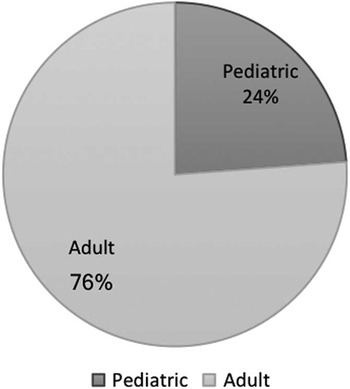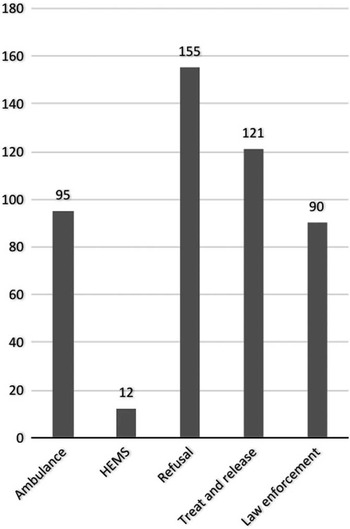Introduction
The United States Border Patrol (USBP) employs approximately 1,000 Emergency Medical Service (EMS) personnel who are embedded in operational units to provide medical support to employees, detainees, and the public. 1 The El Paso (Texas USA) Sector is one of nine Border Patrol Sectors and is responsible for monitoring 268 miles of the southwestern US border of the United States with Mexico. The Sector is comprised of 11 stations and covers the geographical region of the entire state of New Mexico and two counties within far west Texas, encompassing a total area of responsibility (AOR) of 125,500 square miles. 2 While primarily a law enforcement agency within the Department of Homeland Security (Washington, DC USA), the USBP has an active but voluntary EMS component. The EMS in the USBP is considered a collateral responsibility for the agents providing care to those injured within this vast AOR. El Paso Sector USBP EMS personnel operate primarily at the emergency medical technician-basic level; however, 12% of the EMS providers are at the Advanced Life Support level. Approximately 50% of the providers received their EMS training prior to starting their service with the USBP in either civilian or military training programs, and the other 50% are trained while on active USBP service.
Studies have attempted to analyze border crossing injuries due to falls from fences in the past. 3 , Reference McLean and Tyroch 4 The US Government Accountability Office (Washington, DC USA) has reported on deaths that occur during emigration and immigration.Reference Ekstrand 5 To date, no studies have examined the utilization and types of injures encountered by the USBP EMS service in the El Paso Sector. This review did exclude injuries that were cared for by the Border Patrol’s special operation teams, the Border Patrol Search, Trauma, and Rescue (BORSTAR) units, stationed in the same AOR as they utilize a separate electronic medical record (EMR). This study evaluates the use of the USBP EMS service and types of injuries that occur along the US Mexico border.
Methods
All El Paso Sector USBP EMS prehospital information was reviewed from February 6, 2014 (which coincides with the implementation of an EMR system) through February 6, 2016. No documented patient encounters were excluded from analysis during the study time frame. For each patient encounter that generated a report, the EMR captured information about the age, gender, chief complaint, primary and secondary provider impression, mechanism of injury, and location of call. Information was confirmed by a manual review of the chart by the author to include evaluation of information in the narrative which may have been omitted in the EMR voluntary capture fields. All patient information was de-identified electronically ensuring patient confidentiality. The resulting data were analyzed using descriptive statistical analysis. The study received approval from the USBP and was approved by the Human Subjects Protection Program at the University of New Mexico (Albuquerque, New Mexico USA).
Results
There were 473 documented patient encounters by USBP EMS providers during the study period, 267 in the first year and 180 in the second year. Documentation of a patient’s citizenship is not a routine part of the EMS medical record, but 44 of the patients treated by the USBP were documented as United States citizens and another 43 patients that were treated were USBP agents injured in the line of duty.
Of the 473 patients, 63.0% (n=297) were male and 37.0% (n=176) were female. The age of the patient was documented in 470 charts and revealed 24.0% (n=112) of patients were less than 18 years old and 76.0% (n=358) were adults age 18 or older (Figure 1). The ages encountered spanned from three months old to 82 years old with a majority between 22-40 years old (Figure 2). The documented ethnicity of the patients was Hispanic (90.0%; n=419), Caucasian (8.0%; n=40), and other (2.0%; n=9).

Figure 1 Percentage Adult and Pediatric Patients.

Figure 2 Patient Age Distribution.
Figure 3 demonstrates the most common chief complaints encountered by USBP EMS agents. The most common complaint was an extremity injury or pain (35.0%; n=125), followed by rash (13.0%; n=46), and laceration or abrasion (9.4%; n=33) as the third most common patient complaint. A closer look at the rashes revealed 25 (58.0%) were in the pediatric population. Also noted were 24 individuals complaining of abdominal pain, of which 16 (67.0%) reported drinking surface water in the desert due to an insufficient supply of fresh or bottled water. Among all patients, 192 reported suffering from “pain” (55.0%).

Figure 3 Most Common Patient Chief Complaint. Abbreviation: AMS, altered mental status.
The EMS call types seen by the USBP in the El Paso Sector were 55.0% medical, 42.0% trauma, and 3.0% without a chief complaint (Figure 4).

Figure 4 USBP EMS Call Type. Abbreviations: EMS, Emergency Medical Services; USBP, United States Border Patrol.
The provider primary impression was overwhelmingly traumatic injury (34.0%; n=162), with fever/infection the second most common (16.7%; n=79), and extremity injury the third most common (7.0%; n=34). Of the patients that were given a secondary impression by the treating EMS provider (n=353), the most common finding was an extremity injury (20.0%; n=71), rash (13.6%; n=48), and hemorrhage/laceration (8.8%; n=31). Figure 5 demonstrates the complete primary and secondary impressions given by USBP EMS providers.

Figure 5 USBP EMS Agent Primary and Secondary Patient Impression. Abbreviations: CHF, congestive heart failure; CVA, cerebrovascular accident; EMS, Emergency Medical Services; GI, gastrointestinal; GU, genitourinary; LOC, level of consciousness; MVA, motor vehicle accident; SOB, shortness of breath; TBI, traumatic brain injury; URI, upper respiratory infection; USBP, United States Border Patrol.
An analysis of the mechanism of injury demonstrated the most common injury occurred from a fall (30.0%; n=87), followed by a motor vehicle accident (MVA; 23.0%; n=67), and environmental exposure (10.0%; n=30), as illustrated in Figure 6. When falls were analyzed, 48.0% (n=42) were from a fence, and of those, eight were from 10 feet and only four falls were from a height greater than 10 feet, while 45.0% (n=39) were ground-level falls. There were two falls from a canal, three individuals fell from a train, and one from a horse, which in total accounted for six additional injuries from a fall (Figure 7). Of the MVAs, the USBP EMS agents were the first prehospital provider on scene 96.0% of the time (n=79).

Figure 6 Mechanism of Injury. Abbreviations: ATV, all-terrain vehicle; GSW, gunshot wound; MCC, major complications/comorbidities; MVA, motor vehicle accident.

Figure 7 Fall Type.
The USBP El Paso Sector does not transport patients as they are primarily a law enforcement agency and do not operate any transport capable units. The dispositions of the 473 patients were analyzed and demonstrated 95 patients transported by ambulance (20.0%); 12 patients transported by helicopter (2.5%); 90 patients turned over to a law enforcement agency, either to USBP agents or local area law enforcement officers (19.0%); 121 were treat and release patients (25.5%); and 155 were refusals (33.0%; Figure 8).

Figure 8 Patient Disposition. Abbreviation: HEMS, Helicopter Emergency Medical Services.
Discussion
This study examined the utilization of USBP EMS in the Southwest US El Paso AOR. It is important to understand the impact that this segment of the population will have on USBP EMS and local area resources.
A majority of the information on the injury patterns of those receiving aid from the USBP EMS service is obtained from the EMR system used. The purpose of this investigation was to examine the injury patterns and mechanisms among those patients presenting to the USBP EMS agents in the El Paso Sector serving West Texas and the New Mexico border with Mexico. An understanding of the mechanisms, associated injury patterns, and use of the EMS system by this population can be beneficial to the emergency physician and for EMS planning, operations, and training. The development and evaluation of injury prevention programs could be beneficial in altering the patterns of injuries seen.
The USBP reported 14,495 apprehensions in the El Paso sector in fiscal year 2015 (10/1/14-9/30/15) 3 and 154 EMS patient encounters during the same time frame, revealing over 1.0% USBP EMS utilization rate. It is important to note that the USBP treats many US citizens, and many of the apprehensions that do require medical services may not be evaluated by USBP EMS agents and are transported directly to the local medical facilities by USBP agents or local EMS.
The incidence of falls in the patient population with a traumatic injury was very high (27.0%), and it should not be assumed that the falls were all from the fence separating US and Mexican territories as there are numerous fences in the region separating property and ranches. The falls that were documented from heights ranged from two feet to 20 feet, 12 of the fall patients were from 10 feet or higher, and there was a 31.0% ambulance transport rate among all fall patients.
The second most prevalent mechanism of injury to which USBP EMS agents responded to were MVAs. A total of 79 MVAs received aid from agents, 67 of which were automobiles, six motorcycles, and six all-terrain vehicles. The USBP agents were able to arrive first on scene to 96.0% of the MVAs, rendering aid prior to ambulance arrival. This rapid response and early arrival most likely reflects the location of the USBP permanent vehicle checkpoints located on the highways just on the outskirts of the cities.
The data also reflect a very high rate of rashes and scabies infections. This is a pattern seen in 2014 during a surge of immigrants from Central America, many of which were children. Many of these patients were relocated from other locations to the El Paso Sector and received an evaluation by a local volunteer physician in conjunction with a USBP EMS agent who performed a physical exam on these patients.
Also of note, 11 patients of 32 (34.0%) complaining of abdominal pain admitted to drinking either stock tank water or surface water prior to evaluation by USBP EMS agents and reported running out of clean water to drink.
Limitations
This study had several potential limitations. First, the retrospective methodology subjected the findings to potential problems due to uncontrolled and unknown variables. Second, all the information was based on prehospital EMS assessment and was not confirmed by physician diagnosis, with the exception of the rashes that were confirmed and diagnosed by a US physician. The relationship between EMS assessment and actual injury and illness remains unknown. Finally, USBP El Paso Sector BORSTAR patient encounters were excluded from the current analysis.
Conclusion
A description of the demographics of EMS patient encounters by USBP EMS personnel occurring in the El Paso Sector with an AOR of 125,000 miles is provided. Most of the encounters were from traumatic injury as a result of falls or MVAs. Environmental exposure also caused a high utilization of EMS. The provider diagnoses most commonly encountered were traumatic injury, fever/infection, and extremity injuries. Border Patrol EMS personnel were first on scene in 96.0% of the MVAs they responded to.










